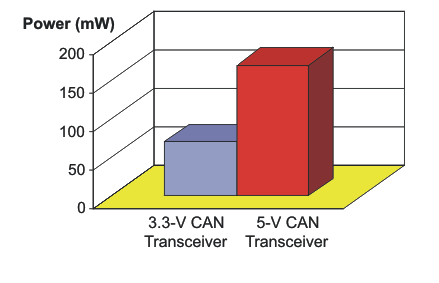SLOA101B August 2002 – May 2016 SN55HVD233-SEP , SN65HVDA1040A-Q1 , SN65HVDA1050A-Q1 , SN65HVDA540-5-Q1 , SN65HVDA540-Q1 , SN65HVDA541-5-Q1 , SN65HVDA541-Q1 , SN65HVDA542-5-Q1 , SN65HVDA542-Q1
-
Introduction to the Controller Area Network (CAN)
- Trademarks
- 1 Introduction
- 2 The CAN Standard
- 3 Standard CAN or Extended CAN
- 4 A CAN Message
- 5
The CAN Bus
- 5.1
CAN Transceiver Features
- 5.1.1 3.3-V Supply Voltage
- 5.1.2 ESD Protection
- 5.1.3 Common-Mode Voltage Operating Range
- 5.1.4 Common-Mode Noise Rejection
- 5.1.5 Controlled Driver Output Transition Times
- 5.1.6 Low-Current Bus Monitor, Standby and Sleep Modes
- 5.1.7 Bus Pin Short-Circuit Protection
- 5.1.8 Thermal Shutdown Protection
- 5.1.9 Bus Input Impedance
- 5.1.10 Glitch-Free Power Up and Power Down
- 5.1.11 Unpowered Node Protection
- 5.1.12 Reference Voltage
- 5.1.13 V-Split
- 5.1.14 Loopback
- 5.1.15 Autobaud Loopback
- 5.2 CAN Transceiver Selection Guide
- 5.1
CAN Transceiver Features
- 6 Conclusion
- 7 Additional Reading
- Revision History
5.1.1 3.3-V Supply Voltage
Most CAN transceivers require a 5-V power supply to reach the signal levels required by the ISO 11898 standard. However, by superior attention to high-efficiency circuit design, the TI 3.3-V CAN transceiver family operates with a 3.3-V power supply and is fully interoperable with 5-V CAN transceivers on the same bus. This allows designers to reduce total node power by 50% or more (Figure 10).
 Figure 10. 3.3-V CAN Transceiver Power Savings
Figure 10. 3.3-V CAN Transceiver Power Savings In addition to the inherent power savings of using a 3.3-V transceiver, for applications using 3.3-V technology, such as the TI TMS320C28xx family of DSPs with integrated CAN controllers, the need for a 5-V power supply can be eliminated. This lowers the overall part count for the node, reducing system cost and increasing system reliability.
For designers with an existing system design which requires a 5-V-powered transceiver, the TI 5-V transceivers are available with a wide variety of features such as high ESD protection and wide common-mode range.